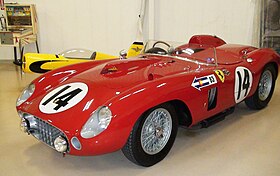
The Ferrari 195 S was a sports racing car produced by Ferrari in 1950. It was an improved version of the 166 MM. The 195 S won Mille Miglia, Coppa della Toscana and Giro delle Calabria.

The Ferrari 250 S was a sports racing car produced by Ferrari in 1952. It was the first in the long lineage of Ferrari 250 road and race cars powered by a ubiquitous 3.0-litre Colombo V12 engine. In 1952 the 250 S won the Mille Miglia and 12 Hours of Pescara. At the Le Mans, the same year, it clocked the fastest race lap time. Only a single example was produced.

The Ferrari 225 S was a sports racing car produced by Ferrari in 1952. It was an evolution over the preceding Ferrari 212 Export with important engine upgrades that greatly improved power output. The model was extensively used in competition, winning many international races. The most important include 1952 Monaco Grand Prix for sports cars, Portuguese Grand Prix, Coppa d'Oro di Sicilia, Coppa della Toscana, Coppa d'Oro delle Dolomiti and many others. It was the final Colombo V12 engine iteration before the 250-family stretched it to 3.0-litres capacity.

The Ferrari Monza is one of a series of cars built by Ferrari. In the early 1950s, Ferrari shifted from using the compact Gioacchino Colombo-designed V12 engine in its smallest class of sports racers to a line of four-cylinder engines designed by Aurelio Lampredi. Inspired by the success of the light and reliable 2.5 L 553 F1 car, the four-cylinder sports racers competed successfully through the late 1950s, culminating with the famed 500 Mondial and 750 Monza.

The Ferrari 212 Export was a sports racing car produced by Ferrari in 1951–1952. The 212 Exports won Tour de France automobile, Giro di Sicilia, Coppa della Toscana, 10 Hours of Messina and other motor races throughout its career. It was meant to be a sports car available for oversea markets.

The Ferrari 375 Plus is a sports racing car produced by Ferrari in 1954. The model competed internationally, winning many major races, including 24 Hours of Le Mans, Carrera Panamericana, 1000km of Buenos Aires, Agadir GP and Silverstone.
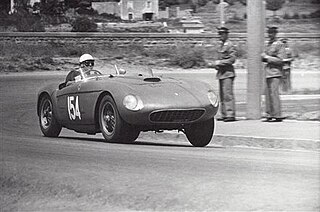
The Ferrari 250 Monza was a sports racing car produced by Ferrari in 1954. It was a combination of a stretched chassis and body from the line of inline-four-engined racers with an ubiquitous 3.0-litre Colombo V12 engine.

The Ferrari 315 S was a sports racing car produced by Ferrari in 1957. The model was intended to succeed the Ferrari 290 MM, which had won the 1956 Mille Miglia.

The 23. edizione Mille Miglia was an auto race held on a 992.332 mile (1597 km) course made up entirely of public roads around Italy, mostly on the outer parts of the country on 28–29 April 1956. The route was based on a round trip between Brescia and Rome, with start/finish, in Brescia. It was the 3rd round of the 1956 World Sportscar Championship.

The Ferrari 335 S was a sports racing car produced by Italian manufacturer Ferrari in 1957. The car was a direct response to the Maserati 450S which with its 4.5-litre engine was threatening to overpower the 3.8-litre 315 S and 3.5-litre 290 MM. Four cars were produced in total.
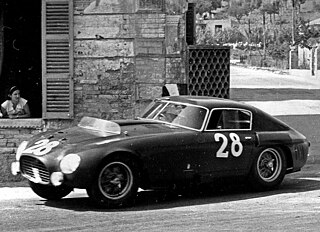
The Ferrari 375 MM, was a sports racing car produced by Ferrari in 1953 up to 1955 for the road cars. It was named "375" for the unitary displacement of one cylinder in the 4.5 L V12 engine, and the "MM" stood for the Mille Miglia race. In total 26 units were made, including four converted from the 340 MM.
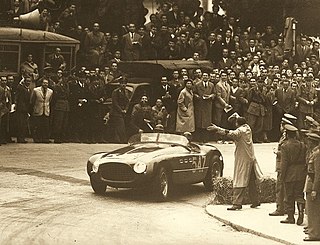
The 1953 Mille Miglia, was the second round of the 1953 F.I.A. World Sportscar Championship and was held on the open-road of Italy, on 26 April 1953. The route was based on a round trip between Brescia and Rome, with start/finish, in Brescia.
The Ferrari-Abarth 166 MM/53, also called Smontabile Spider, is a competition car designed in 1953 by Carlo Abarth for the driver Giulio Musitelli. Its bodywork was a design of Franco Scaglione. The car is a reworking of the Ferrari 166 MM for the driver, the only Abarth reworking of a Ferrari.

Vittorio Jano designed a new 60° V12 engine for sports car racing for Ferrari. This new engine, introduced in 1956, combined elements of both Colombo and Lampredi engines with new features. Engine architecture was more of Lampredi school but retained smaller Colombo internal measurements. Jano moved to Ferrari along with his designs for the Lancia D50 in 1955 and went on to design not only a new V12 but also a family of the Dino V6 engines soon after. Some of the technical ideas came from the Jano's Lancia V8 DOHC engine, intended for Formula One. This family of engines replaced Lampredi inline-4s known from Ferrari Monza line and went on to win many international races and titles for Ferrari. The design team comprised Jano as well as Vittorio Bellentani, Alberto Massimino, and Andrea Fraschetti.
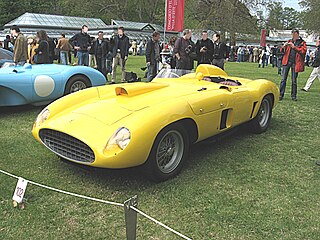
The Ferrari 410 S was a sports racing car produced by Ferrari in 1955–1956. After the racing successes of 375 Plus, mainly in 1954 Carrera Panamericana, Ferrari decided to prepare another model for this marathon. The 410 S was intended as a long-distance race car originally designed for the 1955 Carrera Panamericana and was the final model of the Lampredi V12 sports car lineage. The next generation of sports racing cars that replaced the 410 S were powered by the new Jano V12 engines.

The Ferrari 275 S was a sports racing car produced by Ferrari in 1950. It was the first Ferrari powered by a new Aurelio Lampredi-designed V12 engine, created as a large displacement alternative to the initial 1,5 L Colombo V12, used in supercharged form in Ferrari 125 F1. Formula One regulations allowed for up to 4.5 L in naturally aspirated form.

The Ferrari 250 MM was a sports racing car produced by Ferrari in 1953. After the initial racing successes of the 3.0-litre Colombo V12 engine, introduced in the 250 S one-off, Ferrari produced a serial racing model. It is best recognisable for the distinctive closed berlinetta bodywork by Pinin Farina. The "MM" in its name stood for the Mille Miglia race.

The Ferrari 376 S was a sports racing car produced by Ferrari in 1955. It was the first raced Ferrari powered by a new Aurelio Lampredi-designed inline-6 engine, created as a larger alternative to the inline-4 series of engines used in the Ferrari Monza race cars. The intention behind the development of this model was the 1955 Mille Miglia race. It was yet another attempt by Ferrari to match the new Mercedes-Benz 300 SLR in competition. All of the created cars were further converted into a bigger capacity models.

The Ferrari 735 LM was a sports racing car produced by Ferrari in 1955. It was the second raced Ferrari, powered by an Aurelio Lampredi-designed inline-6 engine, created as a larger displacement evolution to the engines used in the Ferrari Monza race cars.

The Ferrari 290 S was a sports racing car produced by Ferrari in 1957. It was a development of an earlier 290 MM race car that won the 1956 Mille Miglia. The 290 S was the first sports car manufactured by Ferrari to be powered by a DOHC V12 engine. Its career was very short but it served as an important milestone in the Jano V12-powered lineage.
